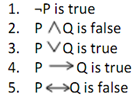Tautologies:
Above given table allows us to read the truth of the connectives in the next manner. Just expect we are looking at row three. It means this says that, if there P is false and Q is true, so

Specified there that, if P is false, so regardless of where Q is true or false, and the statement P→Q is true. Thus this takes a little getting needed to, to be a very important tool in theorem proving: if there we know that there is something false, than it can imply anything we want it to! Just,, the follow next sentence is true: like "Barack Obama is female" it really implies that "Barack Obama is an alien", it means it the premise that Barack Obama is female was false, now the conclusion is Barack Obama is an alien can be deduced in a sound way.
Each of row in a truth table describe the connectives are a particular assignment of true and false to the individual propositions in a sentence. So than we identify each assignment a model like: whenever it represents a particular possible state of the world. So, just for two propositions P and Q there are four models.
Hence, for propositional sentences in generally, there a model is also just a particular assignment of truth values to its individual propositions. If there a sentence with n propositions will have 2n possible models than 2n rows in its truth table. But a sentence S will be true or may false for a given model M - where S is true we say 'M is a model of S'.
Such type of sentences that are always true, regardless of the truth of the individual propositions are known as tautologies or can say valid sentences. There Tautologies are true for all models. Just like for instance, if I said that the "Tony Blair is prime minister or can say like Tony Blair is not prime minister" so there this is largely a content-free sentence it means that we could have replaced the predicate of being Tony Blair with any predicate so the sentence would still have been correct.